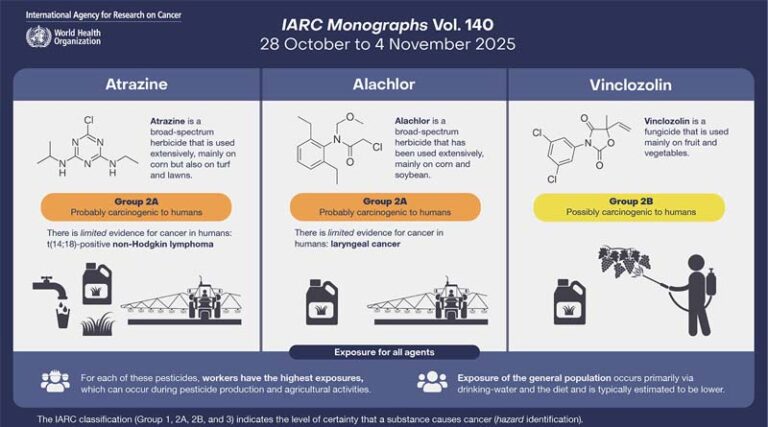
Atrazine and Alachlor Classified as Group 2A “Probably Carcinogenic to Humans”: IARC Monographs Study:
27 November 2025, Lyon: The International Agency for Research on Cancer (IARC) has released its latest assessment on the carcinogenic risks associated with three widely used agriculture chemicals atrazine, alachlor, and vinclozolin. The findings, published in The Lancet Oncology, summarize the conclusions of the IARC Monographs Meeting 140 and bring renewed attention to chemicals long used across global farming systems.
Background and Global Use
Atrazine and alachlor are among the most commonly used herbicides for weed control in crops such as corn, as well as in turf and lawn management. Vinclozolin, a fungicide, is primarily applied to fruits and vegetables. Atrazine had previously undergone evaluation in 1998 under IARC Monographs Volume 73, while alachlor and vinclozolin were assessed for the first time in this latest review.
Findings on Atrazine and Alachlor
The Working Group concluded that both atrazine and alachlor fall under Group 2A – probably carcinogenic to humans. This classification was based on a combination of limited evidence of cancer in humans and sufficient evidence in experimental animal studies. The review also highlighted significant mechanistic evidence supporting carcinogenic activity.
For atrazine, the evaluation pointed to positive associations with a specific form of non-Hodgkin lymphoma marked by the chromosomal translocation t(14;18). Alachlor, meanwhile, showed positive associations with cancer of the larynx, contributing to its classification.
Vinclozolin Classified as Possibly Carcinogenic
Vinclozolin, widely used in horticulture, was classified as Group 2B – possibly carcinogenic to humans. The Working Group noted sufficient evidence of cancer in experimental animals and strong mechanistic evidence in laboratory systems. However, the available evidence in human studies was deemed inadequate, leading to its placement in Group 2B instead of a higher-risk category.
Upcoming Detailed Assessment
The full scientific documentation supporting these classifications will be published as Volume 140 of the IARC Monographs. This comprehensive report will provide deeper insight into the experimental evidence, mechanistic pathways, and epidemiological findings that shaped the Working Group’s conclusions.
Also Read: CNH Industrial Finance Europe S.A. 1.875% Notes Due 2026 Notice Of Redemption
📢 If You’re in Agriculture, Make Sure the Right People Hear Your Story.
From product launches to strategic announcements, Global Agriculture offers unmatched visibility across international agri-business markets. Connect with us at pr@global-agriculture.com to explore editorial and advertising opportunities that reach the right audience, worldwide.






